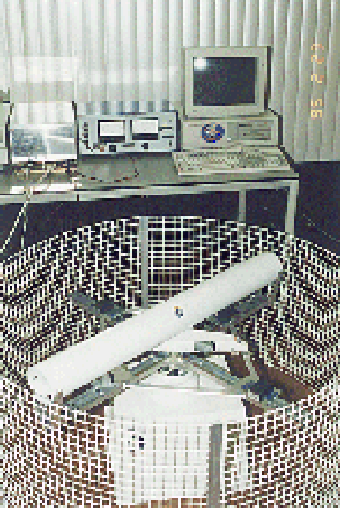Schematic layout of the main components in an Atomic Force Microscope.
Additional and Future Activities
Atomic Force Microscopy (AFM)
Since gravity acts on mass, it might
be expected that changes in cells due to (micro-) gravity are due to intracellular
mass displacements and / or changes in general cell shape. Both processes involve
the cytoskeleton and this might be a focal point for future gravity studies
both on ground as well as for the international space station. For light microscopic
observations the more advanced Confocal Laser Scanning Microscope (CLSM) has
been used to study intracellular static or dynamic processes. For the CLSM a
sample has to be labeled / stained with a fluorescent probe and may then be
studied in a three-dimensional way by reconstructing a series of optical sections.
In recent years the Atomic Force Microscope (AFM) has become available to also
study biological samples. Although both systems have their particularities,
the AFM has some advantages over a CLSM. The AFM is a very compact system and
provides high spatial resolutions as well as the possibility to visualize living
cells in vitro. An AFM is also a powerful instrument to study ligant binding
forces or in situ DNA repair processes.
In this pilot project set up with Prof. van Hulst from the University of Twente,
Optical Techniques
Group, we plan to integrate and AFM onto a centrifuge. In such a setup it
would be possible to study morphological changes at the cell surface and even
underlying cytoskeleton structures.
Schematic layout of the main components in an Atomic Force Microscope.
See for full paper: 1999: van Loon J..J.W.A, van Hulst N.F. 'Atomic Force Microscopy as Tool in Cell Biological research for Ground Based and In-flight Studies'. Publications: abstracts/posters.
Launch simulations
Besides the use of the MidiCAR centrifuge for dynamic changes in acceleration such as during rocker launches, also the vibration levels may be considered for preflight experiment preparations.
A facility to test launch accelerations, vibrations and acoustic stress for small experiments and payloads, the MaxiCAR / VariCAR has been under study. This facility could be used to study effects of launch vibrations on cells, tissues or small payloads.

A breadboard of the MaxiCAR simulator
for launch accelerations and vibration.